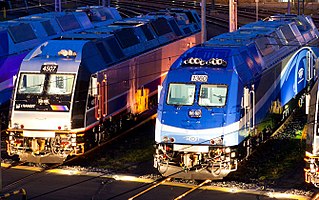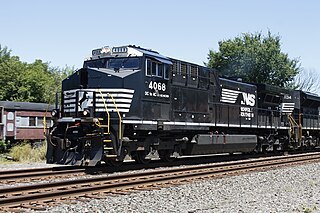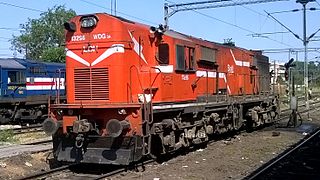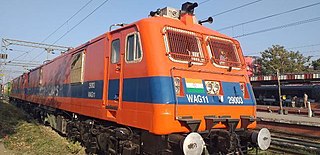
The SD80MAC was a 5,000 horsepower (3.7 MW) C-C diesel-electric locomotive. It was powered by a 20-cylinder version of EMD's 710G prime mover, and was the second diesel locomotive by GM-EMD to use a V20 engine, since EMD's SD45 series. It introduced a wide radiator housing similar to GE Transportation locomotives and the placement of dynamic brakes at the rear of the locomotive, which is a quieter location, features that were incorporated into the SD90MAC and SD70ACe models. Key spotting differences between the SD80MAC and SD90MAC include no external rear sandbox on the SD90MAC, no rear lighted number boards on the SD90MAC, and the placement of the front numberboards. The SD80MAC also had recessed red marker lights in the nose, an identifying feature unique to Conrail (CR) locomotives, although Norfolk Southern (NS) had removed the lights on most of their former Conrail engines.

GE Transportation is a division of Wabtec. It was known as GE Rail and owned by General Electric until sold to Wabtec on February 25, 2019. The organization manufactures equipment for the railroad, marine, mining, drilling and energy generation industries. The company was founded in 1907. It is headquartered in Pittsburgh, Pennsylvania, while its main manufacturing facility is located in Erie, Pennsylvania. Locomotives are assembled at the Erie plant, while engine manufacturing takes place in Grove City, Pennsylvania. In May 2011, the company announced plans to build a second locomotive factory in Fort Worth, Texas, which opened in January 2013.

The Evolution Series is a line of diesel locomotives built by GE Transportation Systems, initially designed to meet the U.S. EPA's Tier 2 locomotive emissions standards that took effect in 2005. The line is the direct successor to the GE Dash 9 Series. The first pre-production units were built in 2003. Evolution Series locomotives are equipped with either AC or DC traction motors, depending on the customer's preference. All are powered by the GE GEVO engine.

The Indian locomotive class WDG-4 is a type of six-axle (Co-Co) freight-hauling diesel-electric locomotive with AC electric transmission designed by General Motors Electro-Motive Diesel in 1997–1998 for Indian Railways, where they are classed as WDG-4. Derived from the EMD SD70MAC, it is powered by a 4,000 hp (3,000 kW) 16-cylinder EMD 710G3B prime mover. Thirteen were built by EMD as order #958647, and a further eight were exported in kit form and assembled in India. The class entered service in 1999. This locomotive is also famous for, and can be identified by the distinct Jet Aeroplane-like sounding capability of its EMD 710 prime mover.

The Indian locomotive class WDP-4 is a passenger-hauling diesel-electric locomotive with AC electric transmission designed by General Motors Electro-Motive Division and built by both GM-EMD and under license by Banaras Locomotive Works (BLW) of Varanasi, India for Indian Railways as the classes WDP4, WDP4B and WDP4D. The GT46PAC is a passenger version of the previous Indian Railways EMD GT46MAC freight locomotive. The locomotive has a 16-cylinder 710G3B diesel engine and is one of the fastest diesel-electric locomotives in service in Indian Railways.
The ALCO DL560C is a series of diesel-electric locomotive with AC electric transmission designed by the American Locomotive Company and produced under license by Banaras Locomotive Works (BLW) Varanasi, India for Indian Railways as their classes WDM-2, WDM-3A/2C, WDM-3D and WDG-3A for operation in India. The locomotive is fitted with a 16-cylinder ALCO 251 B,C diesel engine. In the early 1960s Indian Railways needed a reliable diesel workhorse to gradually replace its steam locomotive fleet. Equal numbers of ALCO's DL560C and EMD's G16 were chosen for trials. More locomotives of each of these were purchased for more trials. Indian Railways was keen on producing these locomotives in the country rather than depending on imports. EMD did not agree for a Transfer-of-Technology, while ALCO did. Thus ALCO DL560C was chosen for the job due to its easy maintenance, reliability and simple operation. And from then on vast numbers of this loco in different configurations have been produced and remain the main diesel traction power of Indian Railways.

The Bombardier ALP-45DP is a type of single cab dual-mode locomotive operated by New Jersey Transit and Exo. The locomotive was designed and originally built by Bombardier until 2021, and by Alstom since 2021.

The GE PowerHaul is a class of mainline diesel-electric locomotives designed by General Electric. Thirty locomotives were ordered by Freightliner in 2007; the first locomotive was completed in July 2009 at GE's Erie, Pennsylvania, plant.

The Indian locomotive class WAG-12B is a class of 25 kV AC electric locomotives that was developed in 2017 by Alstom with technological collaboration with Indian Railways. The model name stands for wide gauge(W), Alternating Current (A), Goods traffic (G) locomotive-12 . They entered trial service in 2019. A total of 410 WAG-12B have been built at Electric Locomotive Factory, Madhepura, Bihar, India.

The GE AC44C6M is an AC-traction 4,400-horsepower (3,300 kW) diesel locomotive, rebuilt from GE Transportation Dash 9 locomotives. AC44C6M rebuilds have been done by GE, American Motive Power, Inc., and Norfolk Southern Railway's Juniata and Roanoke Shops, starting in September 2015. The AC44C6M retains the 16-cylinder 7FDL-16 prime mover used in the core locomotive prior to rebuilding, but replaces the Dash 9's DC traction motors with alternating current GE 5GEB13B7 traction motors. Externally, the rebuilds have received new wide-nosed cabs, a new front hood section, and a new inverter cabinet behind the cab, while retaining the underframe and engine and radiator compartments of the original Dash 9 units.

Diesel Loco Shed, Gooty is an engine shed located in Gooty, Andhra Pradesh in India. It falls under the jurisdiction of Guntakal railway division of South Central Railway zone.
The Diesel Locomotive Factory, Marhowrah is a joint venture of GE Transportation, part of American company Wabtec, with Indian Railways for the production of 1000 high-power freight locomotives over a period of 10 years designed to run on Indian railway tracks. This factory is located at Marhaura and started manufacturing the locomotives from September 2018.

The Indian locomotive class WDG-3A is a class of diesel-electric locomotive that was developed in 1994 by Banaras Locomotive Works (BLW),Varanasi for Indian Railways. The model name stands for broad-gauge (W), Diesel (D), Goods traffic (G) engine, 3,100 hp (3A) locomotive. They entered service on 18 July 1995. A total of 1,164 WDG-3A units were built between 1994 and 2015 at BLW, Varanasi with a few units being produced by Diesel Loco Modernisation Works (DLMW) and Parel Workshop.

The Indian locomotive class WDG-6G is a class of diesel-electric locomotive used by the Indian Railways for freight duty. The locomotive is a higher power variant of the WDG-4G locomotive which was also designed by General Electric. The design platform is based on the GE Evolution Series and features a 4-stroke 16-cylinder fully turbocharged engine which delivers around 6,000 horsepower, making it the most powerful diesel locomotive of IR. It is the only 6,000 HP Diesel electric locomotive at 23t/axle weight, making it the lightest locomotive in its category in the world.

The Indian locomotive class WAG-11 is a class of twin-section 25 kV AC electric locomotives that was developed in 2018 by Banaras Locomotive Works (BLW), Varanasi for Indian Railways. This freight engine has been designed for 105-km/hourspeed and weighs 252 tons. It is equipped with three-phase induction motor, four power converters and regenerative as well as pneumatic braking system. The model name stands for broad gauge (W), Alternating Current (A), Goods traffic (G), and 11th in series (11). They entered trials service in 2019. A total of 4 WAG-11 pairs have been built by Banaras Locomotive Works (BLW), Varanasi.
The Indian locomotive class YDM-3 is a class of diesel-electric locomotive that was developed in 1964 by GM-EMD for Indian Railways. The model name stands for Metre gauge (Y), Diesel (D), Mixed traffic (M) engine, 3rd generation (3). They entered service in 1962. A total of 30 YDM-3 locomotives was built between 1961 and 1962.

The Indian locomotive class WDG-5 is a class of heavy haul Diesel-electric locomotive built by Banaras Locomotive Works, Varanasi in collaboration with Electro-Motive Diesel. At a rated power output of 5,500 horsepower (4,100 kW), it is the second most powerful diesel locomotive class on Indian Railways, just out-powered by the 6,000 horsepower (4,500 kW) WDG-6G. Derived from the EMD SD80MAC, it was meant as a direct upgrade to the WDG-4 aka GT46MAC. The locomotive series is named Bheem, after the strong Pandav brother from epic Mahabharata. The loco has the 2-stroke Turbocharged EMD 20N-710G3B-ES of the EMD SD80MAC and an AC-AC transmission. Since the loco has been developed by installing a v20-710 prime mover and replacing the standard v16 in the WDG4 GT46MAC locomotive, the model was re-designated by adding 4 to the predecessor model, with GT-46 becoming GT-50, owing to the number of cylinders going from 16 to 20, thereby making it the First EMD locomotive in the GT-series to use a v20-710 engine.
The WDM-2G is a class of diesel electric genset locomotive used in Indian Railways. It is one of the rarest locomotives in India with only two units being produced by Patiala Locomotive Works (PLW). The locomotives were produced with an intention of being fuel efficient and to be used for light to medium duties such as short passenger runs along with occasional shunting. They are one of the only two classes of locomotives in India to feature multiple prime movers, the other example being WDS-6G, which was designed solely for shunting. They have a rated power of 2,400 HP.
The Wabtec FLXDrive platform is a class of battery-electric locomotives manufactured by Wabtec's GE Transportation subsidiary beginning in 2019. Using a modified version of the GE Evolution Series platform, FLXdrive is Wabtec's first zero-emissions locomotive, storing energy in 20 racks of lithium-ion battery cells. FLXDrive is a hybrid-electric locomotive, meaning it works in conjunction with traditional diesel-electric locomotives to provide regenerative braking for a train. The first-generation locomotives are able to operate 30 to 40 minutes at full power when being not connected to another locomotive.




















